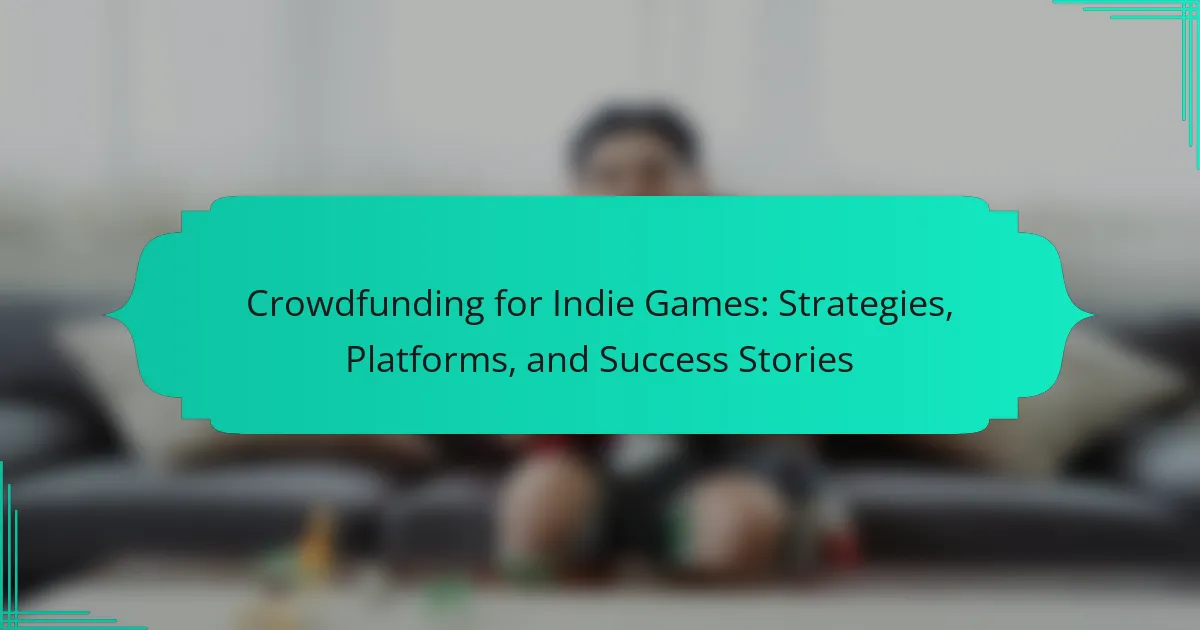Crowdfunding can be a game-changer for indie developers facing funding challenges. Key strategies include building a community, setting realistic goals, and creating engaging content. Choosing the right platform, like Kickstarter or Indiegogo, is crucial for visibility. Success stories from games like “Undertale” and “Hollow Knight” highlight effective approaches and community support.
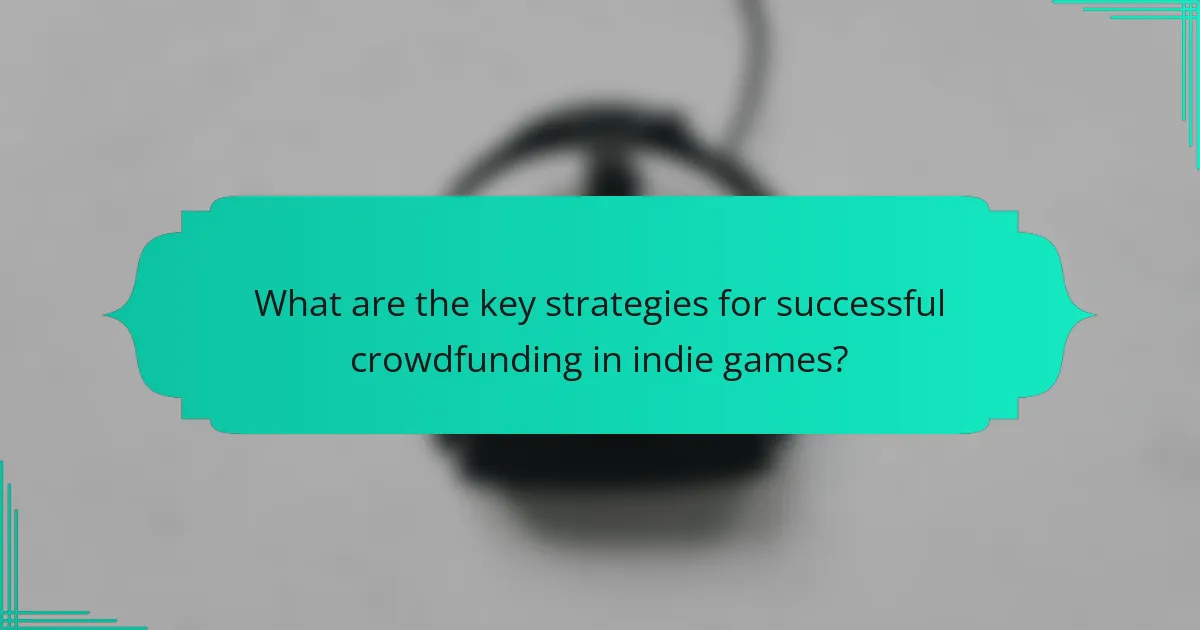
What are the key strategies for successful crowdfunding in indie games?
Successful crowdfunding for indie games requires strategic planning and execution. Key strategies include building a strong community, setting realistic funding goals, and creating engaging content.
1. Build a Community: Engage potential backers early through social media and forums. Establishing a loyal fanbase enhances trust and support.
2. Set Realistic Goals: Determine a funding target based on project needs and market research. Overly ambitious goals can deter backers.
3. Create Engaging Content: Develop high-quality visuals, trailers, and updates. Compelling storytelling can attract and retain backer interest.
4. Leverage Platforms: Choose the right crowdfunding platform, such as Kickstarter or Indiegogo, based on audience reach and features.
5. Showcase Success Stories: Highlight previous successful campaigns to build credibility and inspire confidence among potential backers.
How can storytelling enhance your crowdfunding campaign?
Storytelling can significantly enhance your crowdfunding campaign by creating emotional connections with potential backers. Engaging narratives draw attention and foster trust, which is crucial for indie games.
A compelling story highlights the unique attributes of your game, such as its innovative mechanics or character development. For example, sharing the inspiration behind the game can resonate with audiences, encouraging them to support your vision.
Additionally, storytelling can differentiate your campaign amidst a crowded market. By showcasing personal experiences or challenges faced during development, you can evoke empathy and motivate contributions.
Ultimately, effective storytelling transforms your campaign from a mere funding request into a shared journey, increasing the likelihood of success.
What role does community engagement play in funding success?
Community engagement significantly enhances funding success for indie games by building trust and fostering a loyal supporter base. Engaged communities provide valuable feedback, promote campaigns, and create a sense of ownership among backers. Successful crowdfunding often relies on the strength of these relationships. For example, projects that actively involve their audience in development tend to see higher funding levels. Engaging with potential backers through social media, forums, and events can lead to a broader reach and increased financial support.
Which marketing techniques are most effective for indie game crowdfunding?
Effective marketing techniques for indie game crowdfunding include social media engagement, influencer partnerships, and compelling storytelling. These strategies enhance visibility and attract backers. Utilizing platforms like Kickstarter and Indiegogo can further increase funding potential. Success stories often highlight the importance of community building and regular updates to maintain interest and momentum.
How important is budgeting and financial planning for crowdfunding?
Budgeting and financial planning are crucial for crowdfunding success. They help creators set realistic goals and allocate resources effectively. A well-structured budget enhances credibility, attracting backers. Additionally, financial planning allows for better tracking of expenses and income, ensuring funds are used wisely. Successful campaigns often demonstrate strong financial management, reinforcing trust with potential supporters.
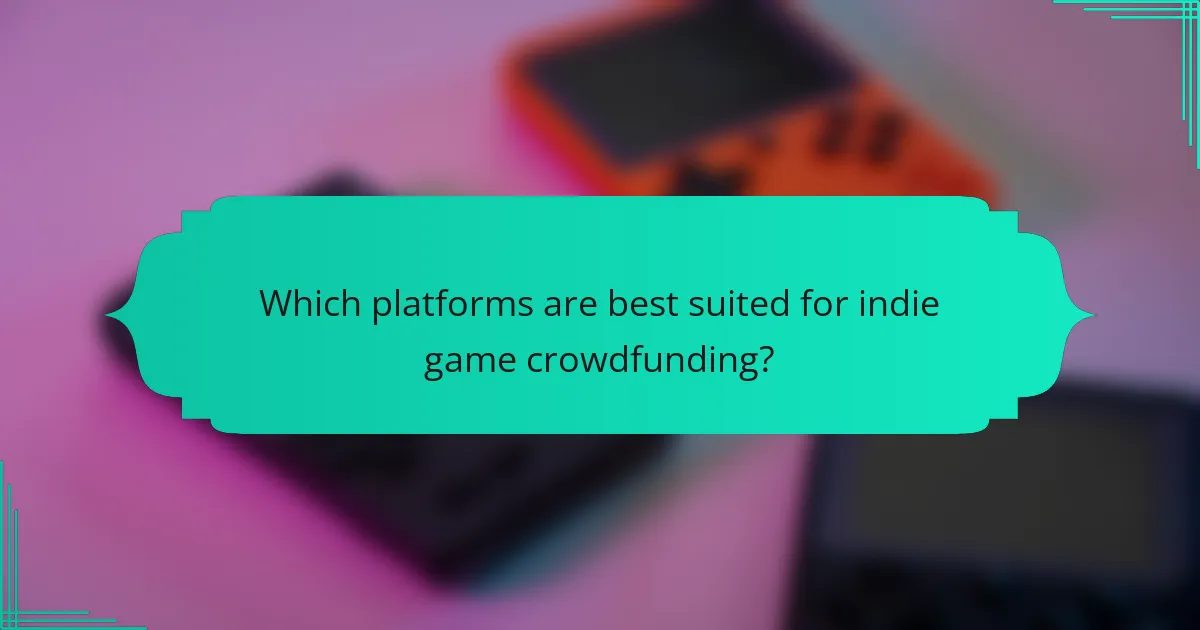
Which platforms are best suited for indie game crowdfunding?
Kickstarter and Indiegogo are the best platforms for indie game crowdfunding. They offer large audiences and established frameworks for project promotion. Kickstarter is known for its all-or-nothing funding model, which can motivate backers to pledge more. Indiegogo allows flexible funding, giving creators access to funds even if they don’t reach their goal. Both platforms feature community engagement tools, helping creators connect with potential backers.
What are the unique features of Kickstarter for indie games?
Kickstarter offers unique features for indie games, including a large, engaged community and flexible funding options. The platform allows creators to showcase their projects with rich visuals and videos, enhancing appeal. Additionally, it provides a tiered reward system, motivating backers with exclusive incentives. The platform’s built-in analytics helps creators track project performance and adjust strategies. Lastly, Kickstarter’s reputation lends credibility, attracting more potential backers to indie game projects.
How does Indiegogo differ from Kickstarter for game developers?
Indiegogo offers more flexible funding options than Kickstarter for game developers. Indiegogo allows creators to keep funds even if the goal is not met, while Kickstarter requires reaching the funding goal to receive any money. Additionally, Indiegogo supports ongoing campaigns, enabling developers to raise funds over a longer period. Conversely, Kickstarter focuses on project-based funding with a defined timeline. This flexibility on Indiegogo can benefit indie game developers seeking varied funding strategies.
What niche crowdfunding platforms should indie developers consider?
Indie developers should consider platforms like Kickstarter, Indiegogo, Fig, Gamefound, and Patreon for crowdfunding. These platforms cater specifically to creative projects, offering unique features and community engagement opportunities.
Kickstarter is renowned for its large audience and project visibility, while Indiegogo provides flexible funding options. Fig allows developers to share profits with backers, enhancing investment appeal. Gamefound specializes in board games but is expanding into digital games, making it a niche option. Patreon offers recurring funding, ideal for ongoing projects and community building.
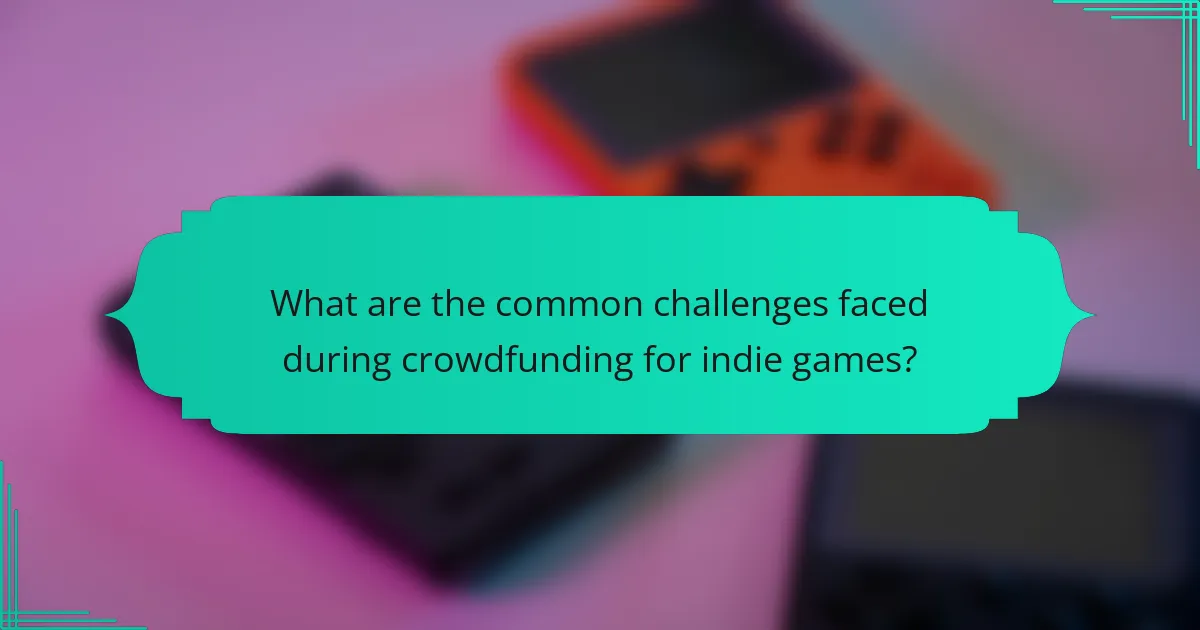
What are the common challenges faced during crowdfunding for indie games?
Indie game developers face several common challenges during crowdfunding, including limited visibility, budget constraints, and community engagement. These hurdles can hinder the success of campaigns and require strategic planning.
Limited visibility affects how many potential backers see the project. Developers often struggle to stand out in a crowded market. Budget constraints restrict marketing efforts, making it difficult to reach a wider audience. Community engagement is crucial; without an established fan base, projects may fail to gain traction.
Additionally, setting realistic funding goals is essential. Overestimating can lead to failure, while underestimating can limit project scope. Communication with backers also poses a challenge; unclear messaging can lead to misunderstandings and mistrust.
Overall, addressing these challenges with effective strategies can significantly improve crowdfunding outcomes for indie games.
How can developers overcome funding shortfalls?
Developers can overcome funding shortfalls by leveraging crowdfunding platforms effectively. They should create compelling campaigns that engage potential backers, showcase unique game features, and set realistic funding goals.
Successful strategies include offering attractive rewards, utilizing social media for promotion, and sharing development progress to build trust. Platforms like Kickstarter and Indiegogo provide valuable exposure and community engagement for indie game projects.
Notable success stories demonstrate that well-planned crowdfunding efforts can exceed funding targets, enabling developers to bring innovative games to market.
What legal considerations should be addressed before launching a campaign?
Legal considerations include intellectual property rights, compliance with crowdfunding regulations, and ensuring accurate disclosures. Protecting trademarks and copyrights is crucial to avoid infringement. Additionally, understanding platform-specific rules and consumer protection laws can mitigate legal risks. Consulting with a legal expert is advisable to navigate these complexities effectively.
How do market trends impact crowdfunding outcomes?
Market trends significantly influence crowdfunding outcomes by shaping public interest and funding dynamics. Emerging trends can enhance visibility and attract backers, while declining trends may deter investment. For instance, the rise of social media marketing has transformed how indie games are promoted, leading to increased funding success rates. Additionally, economic conditions impact disposable income, affecting backers’ willingness to contribute. Successful campaigns often align with current gaming trends, appealing to the preferences of the target audience.
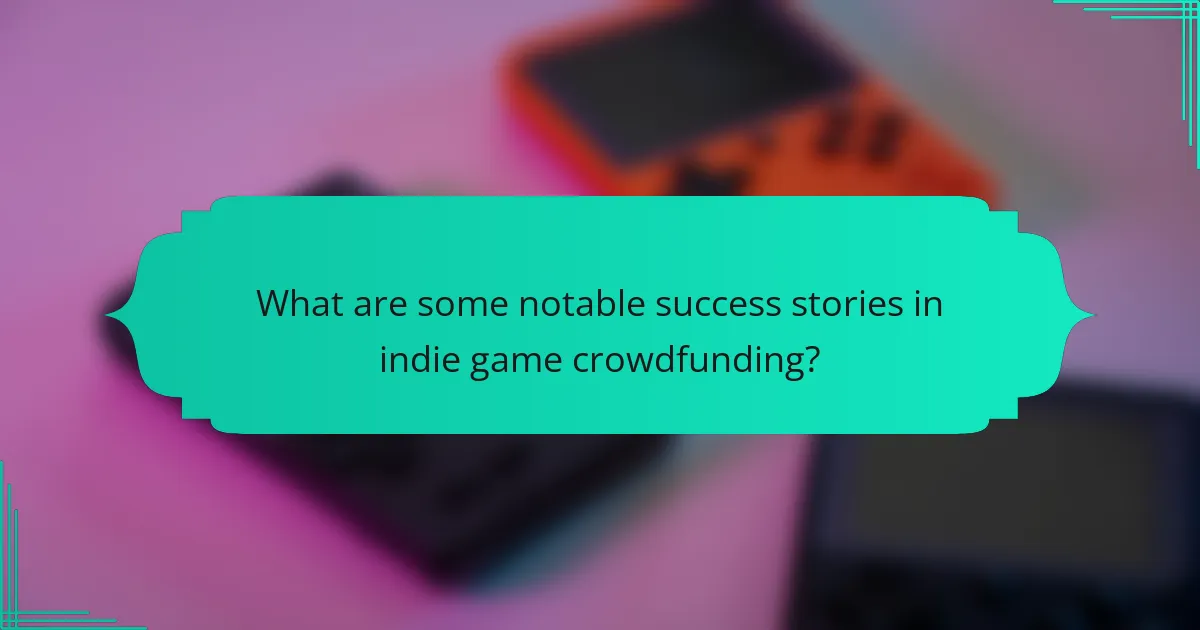
What are some notable success stories in indie game crowdfunding?
Several indie games have achieved remarkable success through crowdfunding. Notable examples include “Undertale,” which raised over $51,000 on Kickstarter, and “Hollow Knight,” which garnered $57,000. “Shovel Knight” also stands out, amassing $311,000, showcasing the potential of crowdfunding for indie developers. These stories illustrate effective strategies and strong community support.
Which games have exceeded their funding goals and why?
Several games have exceeded their funding goals due to strong community engagement, innovative concepts, and effective marketing strategies. Successful campaigns often utilize compelling storytelling and unique gameplay mechanics to attract backers. For instance, “Shovel Knight” raised over $300,000 against a goal of $75,000, driven by nostalgia and a clear vision. “Bloodstained: Ritual of the Night” garnered over $5.5 million, leveraging the reputation of its creator, Koji Igarashi. Additionally, games that offer tangible rewards, such as exclusive in-game items or physical merchandise, tend to perform better in crowdfunding efforts.
What lessons can be learned from failed crowdfunding campaigns?
Failed crowdfunding campaigns reveal crucial lessons for future projects. Key insights include the importance of thorough market research, clear communication of goals, and building a supportive community.
1. Understand your audience: Research demographics and preferences to tailor your campaign effectively.
2. Set realistic funding goals: Analyze costs and establish achievable targets to maintain credibility.
3. Communicate effectively: Clearly articulate your project’s vision and updates to engage backers.
4. Build a community: Foster relationships before launching to ensure a supportive network.
5. Offer compelling rewards: Design attractive incentives that resonate with potential backers.
6. Learn from feedback: Use constructive criticism to refine future campaigns and strategies.
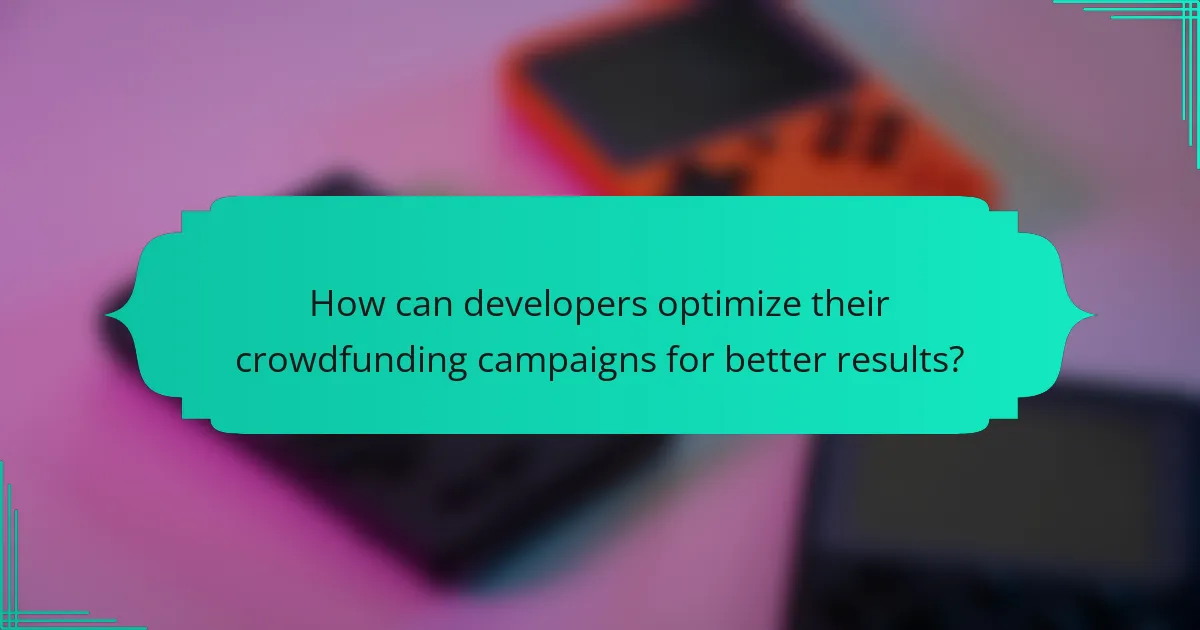
How can developers optimize their crowdfunding campaigns for better results?
Developers can optimize their crowdfunding campaigns by clearly defining their goals, engaging their audience, and showcasing unique game features. Strong visuals and compelling storytelling increase interest, while regular updates maintain backer engagement.
Utilizing platforms like Kickstarter or Indiegogo can enhance visibility, as they attract dedicated gaming communities. Successful campaigns often leverage social media to build momentum and reach potential backers.
Offering enticing rewards, such as exclusive content or early access, can motivate contributions. Analyzing successful case studies reveals the importance of pre-launch marketing and community building for sustained interest.
What best practices should be followed for campaign updates?
To effectively update a crowdfunding campaign for indie games, maintain transparency, engage backers, and provide regular progress reports. Consistent communication fosters trust and encourages continued support.
1. Schedule updates regularly, such as bi-weekly or monthly.
2. Highlight key milestones and achievements to showcase progress.
3. Share challenges faced and how they are being addressed.
4. Include visuals, like images or videos, to make updates engaging.
5. Encourage feedback and interaction from backers to build community.
How can developers effectively use social media to drive funding?
Developers can effectively use social media to drive funding by engaging directly with their audience and building a community around their indie games. They should share regular updates, behind-the-scenes content, and interactive posts to foster interest and excitement.
Platforms like Kickstarter and Indiegogo are essential for crowdfunding, but social media serves as a powerful promotional tool. Developers can utilize platforms such as Twitter, Facebook, and Instagram to reach potential backers. For example, targeted ads on these platforms can increase visibility and attract more funding.
Success stories often highlight developers who effectively leveraged social media. Games like “Shovel Knight” and “Undertale” gained significant attention through consistent social media engagement, leading to successful crowdfunding campaigns. These examples illustrate the importance of a well-planned social media strategy in driving funding for indie games.
What common mistakes should be avoided in crowdfunding campaigns?
Avoiding common mistakes in crowdfunding campaigns is essential for success. Key errors include setting unrealistic funding goals, neglecting marketing efforts, failing to engage with backers, and not providing regular updates. These pitfalls can undermine trust and diminish the likelihood of reaching funding targets.
